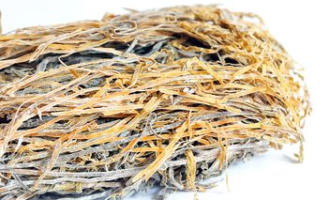Frozen seaweed put in a pot of cold water, bring to a boil and boil for 10 – 15 minutes. Then rinse again and boil again in fresh water, rinse again and boil again in fresh water. Seaweed cooked in this way is tasty and free from unpleasant odors.
Cook canned seaweed for 5 minutes after boiling. Dried cabbage is soaked in cold water for about 10-12 hours, boiled for 20-30 minutes .
Seaweed soup
Attention! This recipe is especially recommended for use in winter – from beriberi and to strengthen the immune system!
Soup products
Beef meat – 300 grams
Seaweed – 200 grams dried or a can of 400 grams canned
Potatoes – 4-5 medium-sized
Carrots – 1 large or 2 small
Onions – 1 head
Sour cream – 1/4 cup
Garlic – 2 cloves
Celery root – 1/2 piece
Butter – a tablespoon
Parsley, dill, black pepper, bay leaf and salt – to taste.
How to cook seaweed
soup Boil beef in a 5-liter saucepan of water, put it out, cool, cut and return. Pass the onions and carrots, add to the pan to the beef. Peel and finely chop the garlic – add to the soup. Add roots, herbs and seasonings. Cook for 10 more minutes.
If dried seaweed is planned for the soup, add it before adding the sauteed onion. If canned – then at the stage of adding seasonings.
Tasty Facts
– Seaweed contains a large number of substances useful to the human body – amino acids, vitamins, phosphorus, magnesium and many others.
– Seaweed cleanses the body of toxins, improves the digestive tract, strengthens the immune system, supports the functions of the thyroid gland, and cleanses the blood.
– Laminaria is recommended for atherosclerosis, hypertension, coronary disease and beriberi, as well as in oncology.
– Calorie content of natural (without additives and cooking) seaweed 5.4 kcal / 100 grams. The calorie content of the finished seaweed salad is about 122 kcal / 100 grams.
– The cost of dried seaweed: 100 grams of dried seaweed can be purchased for 80 rubles. in Korean cuisine stores (on average in Moscow as of June 2017).
– Dry kelp is recommended to be used as salt and sprinkled on prepared dishes. The taste of the products will change somewhat, but you can get used to it pretty quickly.
– In case of kidney diseases, sea kale is not included in the diet. With allergies, furunculosis and acne (acne), the consumption of sea kale should be limited.
– Laminaria accumulates substances dissolved in sea water. It is important that sea kale, harvested in areas with good ecology or specially grown on plantations, gets into food.
